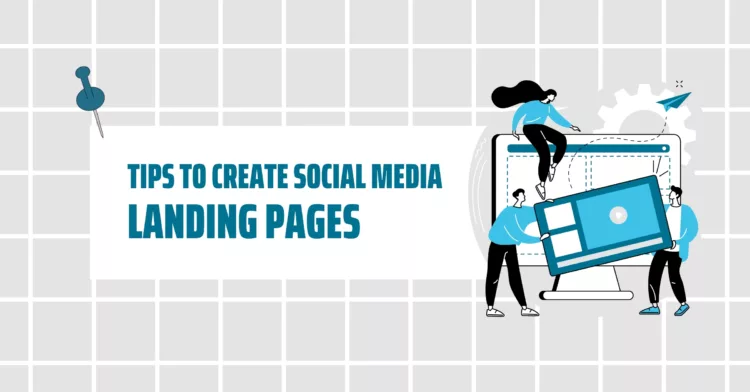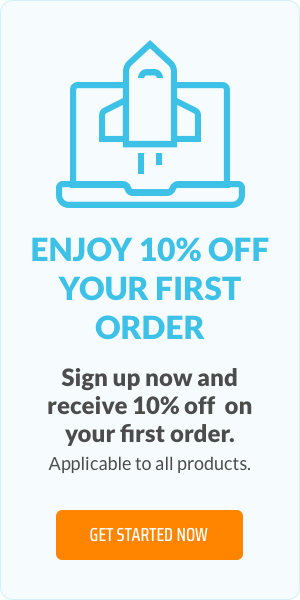Tips to create social media landing pages

A social media landing page is a web page created with a single purpose to optimise to support social media marketing efforts. This article explores why a social media landing page is important. We’ll also share six steps to creating a high-converting social media landing page.
A social media landing page is a unique page created to achieve a single goal for a marketing campaign. The goal may vary depending on what a business wants to achieve. A brand may use it to capture email addresses, sell a product, serve a questionnaire, etc.
Your audience will get to the social media landing page by clicking on an ad or post that you shared on social media.
The landing page gives you more control over the customer experience. It lowers bounce rates and boosts conversions as the page focuses on achieving only one goal.
That said, it is crucial to optimise the landing page so that the incoming traffic doesn't fall through the cracks without converting. In this article, we discuss six simple but effective things to consider to build a compelling social media landing page for maximum conversion.
1. Have a simple design
Making sure a prospect can get everything they need at a glance is key to boosting conversion rates. This is because once someone clicks the link to your social media landing page, they are already interested in your offer.
Therefore, don’t make the landing page any more complex than it needs to be. Your visitors should understand the purpose of the page the second they land on it. This boosts the customer experience and is instrumental in optimising conversions.
A few key landing page elements to prioritise include:
- Headline
- Main description
- Some relevant visuals
- CTA
- Social proof or testimonials
Your description should focus on the product and its key benefits. When writing your description, avoid using buzzwords that sound too complex.
Here’s a simple social media landing page example from HubSpot:
Source: Husbpot
Ideally, use only about two fonts and two theme colours to keep your social media landing page simple and elegant. This will give adequate attention to the CTAs, which are the main elements of your social landing page.
Remember, the main goal of your social media landing page is to get a conversion. All your elements should contribute to that goal.
2. Keep your brand messaging consistent
It is vital to ensure that the content on your social media landing page mirrors that of your social media campaign. It is frustrating when a customer clicks through your ad or social media post only to find that the content on the landing page is completely different from what the ad promised.
Let’s say you have more followers on Instagram than on other social media channels, and you want to use your Instagram page to drive traffic to your social media landing page. Whatever your Instagram stories or posts promote should be mirrored on the landing page.
For example, if the story had a particular offer, the same should be seen on the landing page. If you had an exclusive promotion involving a particular influencer, consider mentioning or including them on the landing page.
The branding colours and text should also largely remain the same. You can add more elements to the landing page but ensure the main parts are consistent and easily recognisable.
Here’s an example of a sponsored social media post.
Explain Ninja (Facebook ad)
Now, take a look at the landing page of that post.
Explain Ninja (landing page)
Notice the consistency from the social media ad to the landing page. Elements like fonts, colours, hero images, headlines, and descriptions remain consistent with only a few changes.
The contact info also needs to be consistent. These confirm to your target audience that they’re in the right place.
3. Include visual elements
Adding relevant visuals can bolster your campaign and give it more traction. Studies conducted by MIT show that people can identify a visual element in just 13 milliseconds. That is faster than most people can read text.
Visuals help to complement the text and written copy. They give potential customers a glimpse into the product or service your brand offers. These can be videos or high-quality images describing your products and services as well as the value they offer the customer.
A visual can convince the prospect to click on the CTA even before they finish reading the written copy on your social media landing page. Be sure to strategically place your CTA close to your visuals in a way that they don't compete but complement each other. Here’s an example:
Notice how Lead Gorilla showcases the product on offer. The “79% off” offer is prominently displayed in a contrasting colour to the background. The CTAs are also in a contrasting colour and strategically placed above the fold, after the headline and description.
This is a great example of how the visuals and CTA of an effective social media landing page can be used together without drawing attention away from each other.
4. Optimise for mobile devices
91% of social media users access social networks using their mobile devices. Meaning that if your site is responsive, more people will be able to access and use it without any inconvenience.
The text and images on your social media landing page should load correctly. They should fit into the user’s screen without them having to scroll horizontally to view the content. Also, have sufficient spacing between text for your audience to read the content with ease.
Additionally, the CTA button should fit nicely on the page to boost social media landing page effectiveness and conversions. The majority of landing page builders create mobile-ready landing pages. This means that if you create your page using the right tool, you don’t have to worry about having a mobile-first or responsive social media landing page.
5. Use a compelling CTA
Once your audience reaches your landing page, you must convince them to convert or purchase. And this is where your CTA comes in.
A strong call-to-action button will help your page viewers take action after seeing what you have to offer. However, a lot of experimentation has to go into finding the right CTA for your business and its audience.
Look for short, simple action words that help your audience know what exactly is expected of them. For instance, let’s say you run a business registration firm and have a social media landing page to help customers start an LLC in Alabama, Texas, or Washington. You could think of using CTAs like “Get Started” or “Speak to an Expert.”
Or if you run an eCommerce store, some of the CTAs you can use for your eCommerce landing page are “Add to Cart” or “Add to Basket.”
You can also incorporate an incentive-oriented CTA like “Get Started Free” and “Start Free Trial.”
Whichever words you choose, make sure the CTA button stands out from the background of your social media landing page. Placement also matters. Therefore, it is a good idea to place the CTA button just below the headline and main description.
In case you have a long landing page, you’ll need to include your CTA at strategic places throughout the page. This lets your prospects take the desired action without having to scroll all the way back to the top.
Run an A/B test to see which social media landing page CTA works best for your brand and use it to achieve your desired results.
6. Test your landing page
Just like the CTA button, it is advisable to test your entire page before settling on one final copy. A/B testing will help you see the page variation with the best results so that you can keep using that version in the future.
For instance, you can use different CTA button colours or different background images to test them out. You can also test different headline variations, text fonts, CTA button placements, and value propositions or offers.
However, when testing the effectiveness of your page, don’t test too many elements at once. Doing this will make it harder to attribute positive results to the specific elements of the page. Test only about two elements at once.
Once the tests have been conducted, and the results are in, adjust your final social media landing page to reflect those changes. The variation with the best results is the one with the highest number of clicks.
In summary
Social media landing pages are critical to optimise the ROI of your social media campaigns. Instead of sending that traffic to your homepage, create a laser-focused landing page. This will help you get more conversions.
To build an effective social media landing page, make it simple and easily comprehensible. Also, maintain consistent brand messaging and branding to confirm to your prospect that they're in the right place. Include relevant visuals like high-quality photos or videos to engage your visitors and bolster your written copy.
Also, ensure your social media landing page is optimised for mobile devices, use a compelling CTA, and A/B test your page.
Author Bio
- Jon Morgan - Founder / Venturesmarter
- Jon is the founder of two successful e-commerce and SaaS businesses. He's passionate about sharing what he has learned from working with business owners through Venture Smarter.
Valentines Day marketing tips for your business
8 ways live chat service influences your website’s SEO And traffic
Related articles:
